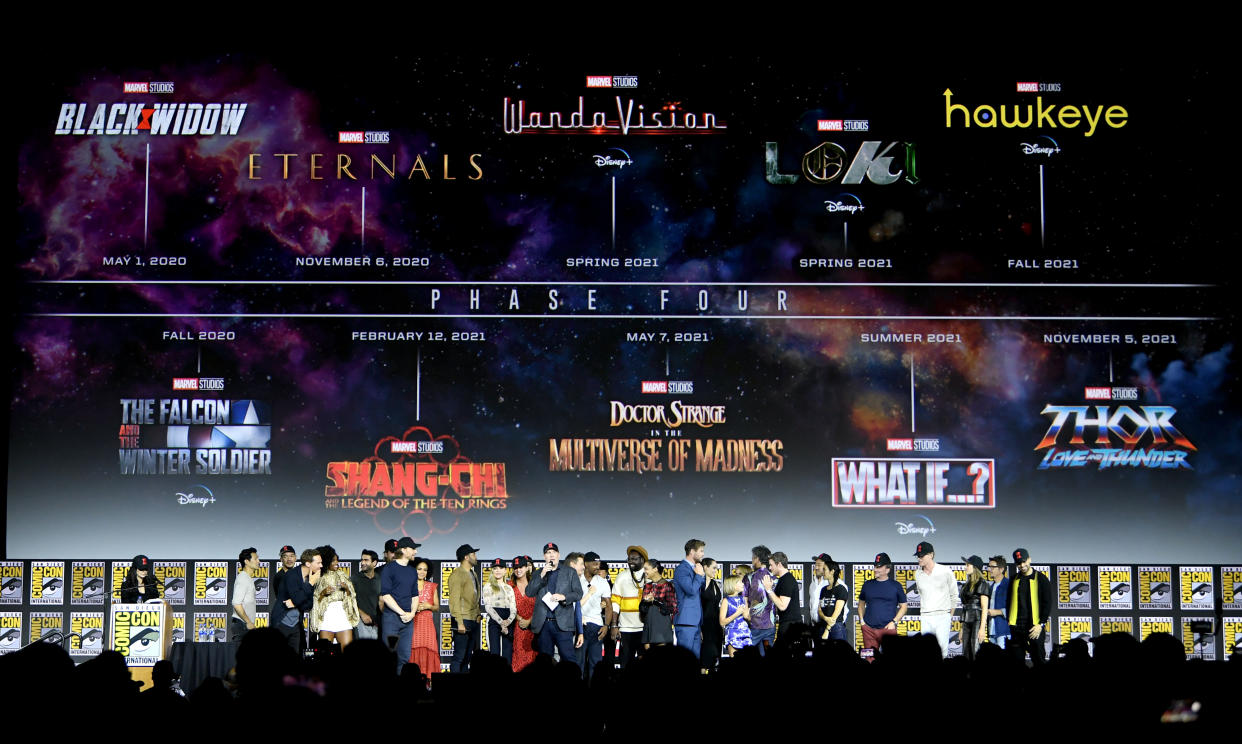Disney will test the limits of 'franchise fatigue' in 2021 and 2022
In November 2019, just a few days after Disney+ launched, Netflix (NFLX) content chief (now co-CEO) Ted Sarandos, speaking at a Paley Center for Media event, said that Disney (DIS) is “bound by” its content universes, a reference mostly to Marvel and Star Wars. He continued: “I do think the risk of being bound in a few universes is that there sometimes may be a melting ice cube of interest over time.”
That has been the most common knock on Disney for a few years now: that if Disney keeps hitting the Marvel and Star Wars piñatas, fans will get tired of it. But the numbers have proven the theory wrong — so far. Moviegoers vote with their wallets, and have voted in favor of more Marvel Cinematic Universe installments, more Star Wars stories.
Six of the top 10 biggest U.S. box office openings of all time were Marvel movies, four of them “Avengers” movies. “Avengers: Endgame” (2019) is the No. 1 box office release of all time. As for Star Wars, the final three films in the “Skywalker” saga, “The Force Awakens” (2015), “The Last Jedi” (2017), and “The Rise of Skywalker” (2019), each topped $1 billion at the global box office, despite fan criticism of the plot of the final film. Spinoff movie “Rogue One” (2017) also hit the $1 billion mark.
A mountain of Marvel and Star Wars content coming
But those were all movies, with much-hyped theatrical releases. On Disney+ over the next two years, Disney will truly test the limits of the fatigue theory with Marvel and Star Wars original shows, and might discover that even the most hardcore fans have a threshold.
The sheer mountain of original content Disney unveiled at its 2020 Investor Day this month was almost comical: 52 new shows or movies coming in the next three years across Disney Studios, Disney Animation, Pixar, Marvel, Lucasfilm, National Geographic, ESPN, and FX.

In the first year of Disney+, only a single live-action original series, “The Mandalorian,” was enough to propel the platform to 86.8 million subscribers.
In 2021, Disney will hit the gas, with six Marvel shows hitting Disney+: “WandaVision” in January; “The Falcon and the Winter Soldier” in March; “Loki” in May; animated series “What If...?” in summer; and a “Ms. Marvel” series and “She-Hulk” series (no specific date given, but Disney said 2021). Can even diehard Marvel fans find the time to watch all of those?
And those are just the television shows. In theaters over the next two years, Disney will release “Black Widow,” “Shang-Chi and the Legend of the Ten Rings,” “Eternals,” “Dr. Strange in the Multiverse of Madness,” “Thor: Love and Thunder,” “Black Panther 2,” and “Captain Marvel 2.”
The Star Wars faucet won’t start blasting until 2022 and 2023, when Disney+ will get the Star Wars spinoff shows “Andor,” “Ahsoka,” “Obi-Wan Kenobi,” “Star Wars: Visions,” “The Bad Batch,” “Rangers of the New Republic,” and “Lando.”
It’s not just Marvel and Star Wars
When critics talk about Disney’s franchise fatigue risk, they’re mostly talking about Marvel and Star Wars, but if you look elsewhere in the Disney+ lineup there are additional examples of the argument.
Disney’s live-action releases coming over the next two years include a “Cheaper by the Dozen” remake movie, another “Lion King” live action movie, and live-action remakes of “The Little Mermaid,” “Pinocchio,” and “Peter Pan,” plus a sequel to “Enchanted,” a Cruella De Vil live-action origin movie, and “Sister Act 3.”
Disney is also planning a “Night at the Museum” animated series, a “Diary of a Wimpy Kid” animated series, and a “Chip N’ Dale” animated movie.
The criticism that almost everything Disney is doing is a prequel, sequel, remake, or spin-off is not unwarranted.
Disney chairman Bob Iger said at the Investor Day presentation that Disney will always prioritize “quality, not volume,” which was hard to take seriously during a five-hour event where the biggest takeaway was quantity. But from a business perspective, the quantity is only a negative if a large number of these shows and movies bomb.

When the “Star Wars” origin film “Solo” made only $393 million at the global box office in 2018, many pointed to it as the first sign of franchise fatigue. But in the next year came “The Rise of Skywalker,” which grossed more than $1 billion, and then “The Mandalorian,” which has been a mega hit, suggesting there is plenty of Star Wars appetite left.
Enough appetite for 10 new Star Wars shows and 10 new Marvel shows on Disney+ per year? That’s the plan, Iger said at Investor Day. That parade of content announcements “was exhausting,” wrote Josh Spiegel, who writes a Substack newsletter about Disney news. “There was too much going on for my tastes... What I mostly got a sense of is that Disney just flat-out can never learn the lesson that it bites off way more than it can chew.”
One retort to the “too much” criticism is that Disney doesn’t need every Star Wars fan to watch every Star Wars movie and show, and doesn’t need every Marvel fan to watch every Marvel movie and show. If a Marvel fan doesn’t like “She-Hulk,” that’s fine, as long as they like “WandaVision” or “Loki.”
The problem is that historically, Star Wars fans and Marvel fans do want to see every piece of content that is part of those universes. The MCU movies in particular each ties to one another with recurring characters and extra scenes after the credits that set up the next movie — they nearly require you to have seen all the movies to get the full experience.
Disney showed restraint with original Disney+ content in 2020. In the next few years, the company is obviously adopting a kitchen-sink strategy to compete with Netflix, and risks losing some franchise fans for good.
—
Daniel Roberts is an editor-at-large at Yahoo Finance and closely covers Disney and the streaming wars. Follow him on Twitter at @readDanwrite.
Read more:
Why Disney is not following Warner Bros in releasing all its 2021 movies straight to streaming
What ‘Queen’s Gambit’ and ‘Mandalorian’ say about Netflix vs Disney original content strategies
Disney+ now has the power to save Disney stock from bad earnings reports
Disney's big streaming re-org is not just about Disney+
Disney, WB are sending a clear signal: Americans aren't ready to return to movie theaters
Disney’s $30 ‘Mulan’ plan will be a litmus test for the entire film industry
Disney's 'Mulan' will look to Christopher Nolan's 'Tenet' for a movie theater health check
Movie theaters seek bailout as coronavirus devastates business
Follow Yahoo Finance on Twitter, Facebook, Instagram, Flipboard, SmartNews, LinkedIn, YouTube, and reddit.
Find live stock market quotes and the latest business and finance news
For tutorials and information on investing and trading stocks, check out Cashay
